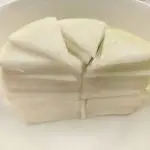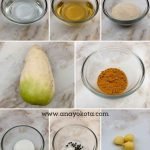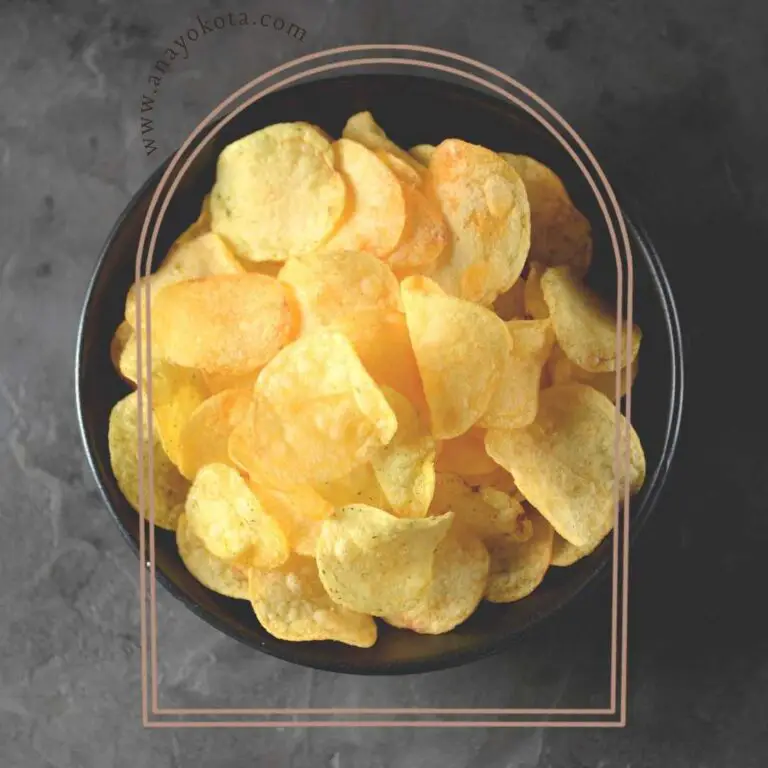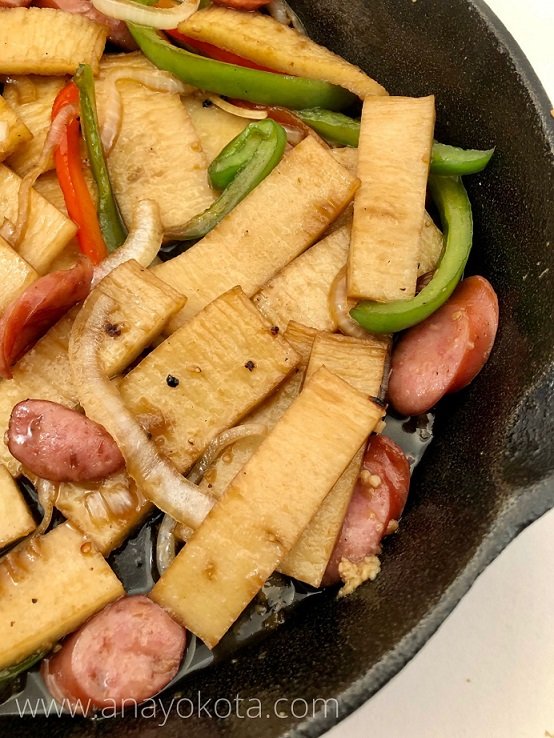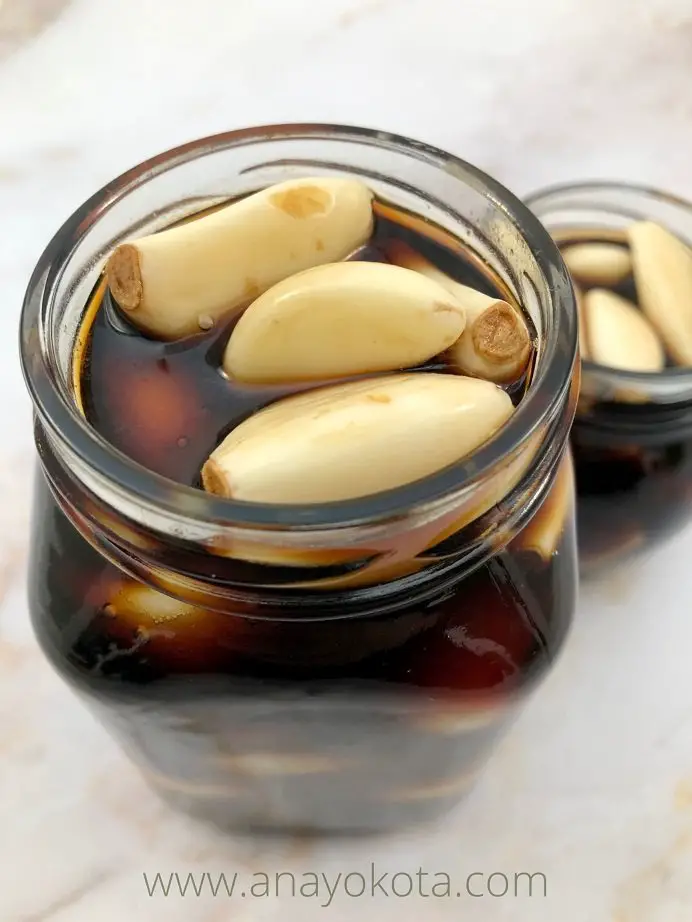This post may contain affiliate links. Please read my disclosure policy for more info.
Korean yellow radish, otherwise known as danmuji in Korean or takuan in Japanese, is a delicious and fun pickled recipe for a sweet and tangy radish that turns yellow.

When I was a child, it was super common for me to eat the yellow version of pickled daikon because it was the best pairing with many Korean picnic foods such as triangle kimbap, sushi, ramyun (ramen), and Korean style Chinese foods. Even when our family would go to Korean restaurants, we would almost always see Korean yellow radish as a banchan (side dish) on the table.
My favorite way to eat Korean yellow radish is with Korean instant noodles and yubuchobap. It has the perfect crunch and just the right amount of tang to help cut the starch.
Korean yellow radish is super easy (almost as easy as the cubed Korean pickled radish) and fun to make with children because you can see the pickling process change the color of the white daikon radish to a brilliant yellow. The ingredients are very simple and healthy and quick to prepare.
WHAT IS KOREAN YELLOW RADISH

Commercialized Korean yellow radish is simply a white daikon radish pickled in vinegar, sugar syrup, water, preservatives and yellow food coloring.
You will hear Koreans refer to this side dish as 단무지 (danmuji) or Japanese refer to this side dish as 沢庵 (takuan). The origin of this yellow pickled radish is from Japan where they would dehydrate white daikon radish and pickle it in a brine with salt, rice bran, sugar, kombu and various aromatics such as pepper, garlic, and vegetable peels. After a few months of pickling, the result would be a tart radish pickle. Though the traditional method of pickling daikon is not as popular, you can still find traditional yellow daikon in Japan.
The most modern and popular method to pickling daikon at home is simply slicing fresh white daikon radish and pickling them in a salty brine mixture for at least a few hours. It is a side dish ready to serve cold, which is traditionally matched with various types of Asian cuisines.
What Makes Korean Radish Yellow?
Typically, the store bought Korean pickled radish slices recipe uses some type of food coloring and sugar syrup to make the daikon yellow. However, in my recipe, I like to use turmeric. kombu, and persimmon vinegar to seep in the coloring agent as it is much healthier and brighter in color.
The first issue in perfecting this recipe is ingredient ratio to produce color and flavor. I have tested a few variations of this recipe and found that even though turmeric helps brighten the appearance of traditional daikon, too much turmeric makes this recipe taste like sour mustard. To offset the flavor of turmeric, I tried a few combinations where either I used more water, vinegar, or sugar. As a result, too much of one ingredient just overpowers the flavors and doesn’t not taste great.
The other issue is shelf life. I personally do not enjoy pickled vegetables that are too salty, too vinegary, or too sweet. But pickling is tricky because you need either or all of those agents to increase longevity. After I found the perfect flavor ratio, I had to figure out how to make this banchan last longer in the refrigerator without adding more salt, vinegar, or sugar. If you don’t use enough ingredients to allow the daikon to pickle, it will not preserve properly. But how do you develop a recipe that is not too tangy, not too sweet, and not too salty without making it go bad quickly?
The answer to this is boiling. Boil the brine and let it cool completely before submerging the daikon radish for pickling. This will allow the daikon to taste fresh and last longer.
How Long Does Korean Yellow Pickled Radish Last?
With my recipe, this will last a few weeks in an airtight container. However, if you want to extend the life of the Korean radish pickle, simply re-boil the brine again, cool completely and resubmerge. With this method, I am able to make large batches and have my Korean yellow radish last for months.
FAQ

How To Store Korean Yellow Radish?
As mentioned earlier, it is very important to store Korean yellow radish in an airtight container and only take out what you will eat/serve. With any kind of pickled vegetable, you want to avoid air exposure as this will expedite the shelf life.
Why Is Korean Radish Yellow?
Historically speaking, Korean radish is yellow because it was adopted by the Japanese culture where special ingredients would alter the color of the daikon. Technically speaking, commercialized Korean radish is yellow due to the yellow food coloring. However, it is very common to find Korean radishes that is white (preserving the natural color of the white daikon) that tastes exactly the same as the yellow pickled radishes.
In my recipe, I use turmeric as it not only adds great flavor and color, but also enhances its health benefits (SOURCE)!
Where To Buy Korean Yellow Pickled Radish?
When friends ask me, “where to buy yellow pickled radish?” I simply tell them they can make it at home – of course. However, not everyone has the time or can get all the ingredients easily.
My recommendations is that you can buy Korean yellow pickled radish at any major Asian supermarket such as H Mart, Zion, Arirang, 99 Ranch, Tokyo Central, Mitzuwa, etc… You can also purchase Korean daikon pickle conveniently on Amazon.
Can I Freeze A Korean Yellow Daikon Or Will It Mess With The Texture Flavour?
I do not recommend freezing Korean yellow daikon because in my experience it does mess with the texture rather than the flavor. The texture will become “limpy” and wilt.
Vegetables What is the difference between a daikon and a turnip?
Both the white daikon radish and turnip are cruciferous vegetables. Turnips are usually round like a small light bulb where a daikon radish can be very large, long, and stumpy. Turnips have a slightly milder peppery flavor while the radish have a slightly sweeter flavor. Both are similar in texture when consumed raw but when cooked, the radish turns translucent and soft while the turnips have a smooth creamier texture.
PRO-TIPS

- Thinly slice. The thinner you slice the daikon radish, the quicker the brine will seep into the radish. However, if you have a few weeks and want to have a slightly longer storage life, I recommend not slicing the radish at all and slice only when you are ready to serve.
- Aromatics. It is not necessary to add the aromatics such as kombu, peppercorns and garlic, however, adding them will only enhance the flavors and give it another health boost.
- Rinse and Serve. It is not necessary but to cut back on the smell as well as the intensity of the briny flavor, I rinse the danmuji recipe and drizzle fresh rice vinegar when I am ready to serve.
KOREAN YELLOW RADISH RECIPE
Cuisine: KoreanDifficulty: Easy1
Jar15
minutes2
hoursKorean yellow radish banchan (side dish) is a sweet and tangy recipe that makes for an easy compliment with rice! The cook time varies depending on how long you let it sit in the fridge.
Ingredients
1 lb (16 oz) – white daikon radish
1 ½ cup (355 ml) – water
1 cup (237 ml) – persimmon vinegar (or any rice vinegar)
¼ cup (57 g) – sugar
1 tbsp (17 g) – salt
½ tsp (1 g) – peppercorns (about 30 peppercorns)
½ tsp (1.59 g) – ground turmeric
3 cloves of garlic sliced
1 (2 inch or 5.08 cm) piece of kombu
Directions
- If you have a few weeks to a month, you do not need to thinly slice the daikon; rather, simply cut it in half moon sections that will fit into an airtight container.
- If you would like to enjoy Korean yellow radish within the next day, cut the daikon in 1-2 inch slices (length and width) that are no more than ¼ inch thick (height) and store in an airtight container.
- Set the daikon to the side and work on the brine mixture.
- In a small saucepan over medium high heat, mix all the remaining ingredients together.

- Bring to a boil and let it simmer for 2-3 minutes whisking occasionally so that all the ingredients are well dissolved.
- Allow the brine to cool completely. Depending on where you are, this should take a couple of hours. Do not cool in the refrigerator.
- Once the brine is completely cooled, gently pour the brine over a daikon until it is fully submerged.
- Store pickled daikon in the refrigerator. For sliced daikon, store for a minimum of 2 hours before serving but the best is storing for about 7-10 days. For whole unsliced daikon, store for a minimum of 3-4 weeks before serving.
- Strongly Recommend: rinse in cold water (only the amount you need) before serving.
Notes
- If you don’t mind the extra briny flavor, skip the rinse step. Regardless if you rinse or serve straight out of the brine, you will reap the wonderful health benefits in pickled daikon radish.

To learn more about the health benefits as well as learn how to make cubed Korean pickled daikon check out the article for more inspiration.
What are your favorite ways to enjoy Korean yellow radish? Have you tried it on pizza or even with a burrito? I know it sounds strange but sometimes that nice pickled punch is exactly what takes food to the next level.
If you would like to learn more pickled vegetable recipes, please let me know in the comments below! I love testing new recipes and would love to share them with you.





